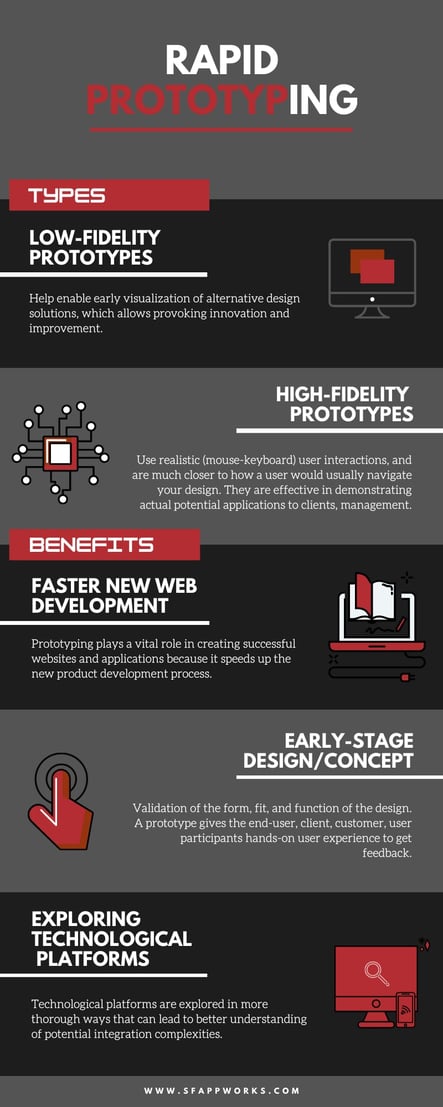Prototyping is a vital part of the engineering design process, but traditionally, it has been a bottleneck. Time, money, and personnel are often taxed with increased demands of building and testing prototypes to keep up with growing markets.
Here at SF AppWorks we frequently come across different types of rapid prototyping and get questions like what is a high-fidelity prototype? Is it a functional model? Is it a mock-up, a simulation of the product, a base to create an MVP?
App designers and website builders often work with clickable prototypes or proofs-of-concept, but building functional prototypes can sometimes lead down a rabbit hole that requires comparable effort to polished products. In software engineering, an iterative process that builds upon previous prototypes will in turn, produce a more robust app or website, but speed of deployment is critical, which is why teams are now turning to Rapid Prototyping to validate ideas and build incrementally.
Looking to explore and develop innovative technologies? SF AppWorks is a progressive digital agency that can help.
What is rapid prototyping?
Rapid prototyping is a combination of techniques used to quickly create a website or application built upon a series of iterative steps that incorporate design sketches, feedback, and tweaks based on that feedback. It is a way of expediting the prototyping process to move as quickly as possible without spending time on detailed prototypes that may end up not looking like the final product.
Related: What is Rapid Prototyping
Types of prototypes
Prototypes can be categorized depending on the degree of quality required, i.e., "Fidelity" or the product development stage.
Fidelity types
Prototypes don't need to look like final products and can differ depending on what the website or application designer is trying to accomplish from the prototype. Rapid prototypes can be classified in terms of exactness or "Fidelity," and the quality of prototype accuracy can vary from basic low-fidelity to high-fidelity in its functionality, appearance, and user interface.
Low-fidelity prototypes help enable early visualization of alternative design solutions, which allows provoking innovation and improvement. They are simple and produced very quickly to test the broader concept, e.g. Paper sketches.
High-fidelity prototypes typically use realistic (mouse-keyboard) user interactions, and are much closer to how a user would usually navigate your design. It creates a close likeness possible to an accurate representation of the user interface. They are more effective in accumulating accurate human performance data (e.g., time to complete a task), and in demonstrating actual potential applications to clients, management, and others.
Get a Free Copy Of 'What To Expect From A Clickable Prototype?'
.png?width=579&name=clickable%20prototype%20basics%20(11).png)
Both types have noticeable differences and advantages. While low-fidelity prototypes are faster to create in theory, they lack much of the user interface experience of the high-fidelity prototype. In turn, while high-fidelity prototypes look closer to the actual user experience, they are more time consuming than low-fidelity types. Often, you’ll find the rapid prototyping pipeline a mix of both fidelity types, since low can turn into high, and vice versa.
Why is Rapid Prototyping Essential?
Companies need to improve and introduce new websites and apps quickly to remain competitive and relevant in the fast-moving modern consumer market. Since high-speed product development and technology innovation are critical to a company's success, rapid prototyping becomes an essential component of new web development. The following objectives are accomplished through rapid prototyping.
- Faster new web development – Prototyping plays a vital role in creating successful websites and applications because it speeds up the new product development process.
- Early-stage design/concept validation of the form, fit, and function of the design.
- Final stage product verification against the technical requirement and business objectives.
- It allows functionality testing to test the objectives of the concept and to finalize the specification.
- A prototype gives the end-user, client, customer, user participants hands-on user experience to get feedback.
- Technological platforms are explored in more thorough ways that can lead to better understanding of potential integration complexities.
The final product, in many ways, is a product of its prototyping process.
Rather than picking one platform to heavily invest in, perhaps for years to come, Rapid Prototyping allows you to integrate a proof of concept on each platform to see exactly how they perform in different scenarios. You may spend a sprint or two upfront doing that work, but you may save months switching platforms down the road.
- Andrew Greenstein - CEO at SF AppWorks
Related: A Breakdown of Our Rapid Prototyping Model
Why Should I Use Rapid Prototyping for My Website or Application?
Rapid prototyping allows designers to work at their best by making feedback an integral part of their process, a rare opportunity that few designers can take advantage of given how quickly the market moves. With how fast rapid prototyping improves your prototype-to-product pipeline, each iterative step brings you closer to the vision of your stakeholders and clients while keeping them in the loop every step of the way. This produces happier clients, faster products, and quicker turnaround time.
Looking for Assistance with Rapid Prototyping? SF AppWorks can help.
Here's a stop motion lego dramatization of an organization that invests months, heck years into the development process without employing Rapid Prototyping to first research and determine the strengths and weaknesses of different platforms.
Pros of rapid prototyping
-
Allows functionality testing
-
Reduced design & development time
-
Improved and increased user involvement
-
Reduced overall product development cost
-
Ability to evaluate human factors and ergonomics
Cons of rapid prototyping
-
Lack of accuracy
-
Increased upfront investment, IF a final product is developed
-
The different types of resources that can be used are limited
-
Some rapid prototyping processes, especially high-fidelity, are still expensive and not economical
-
Overlooking some critical features because it cannot be prototyped
-
End-user confusion, customers mistaking it for the finished project/developer misunderstanding of user objectives
Curious about the different types of Rapid Prototyping? Check out this infographic to explore the key types and benefits of using prototypes

Sorting Out the Different Types of Rapid Prototyping Dilemma
Rapid prototyping benefits companies by turning ideas into realistic proofs of concept. It advances these concepts to high-fidelity prototypes that are fully functional, like final products. It guides the products through a series of validation stages approaching launch for all users to consume.
Questions? Hit us up at info@sfappworks.com or text us at 918-373-9364.
Check out our Latest Resource 'Actionable Steps to Digital Transformation. Real-World Examples On How Companies Made Significantly More Money Than What They Invested'
%20(1).png?width=379&name=digital%20transformation%20mockup%20(2)%20(1).png)
Related: A Digital Transformation Roadmap Deployed in 11 Steps (2022)
Rapid prototyping allows for flexibility in creating clickable prototypes and accelerates the process of validating an idea . Turbocharge your website or app and digitize your business, operations, and customer experiences to meet changing market demands.





COMMENTS